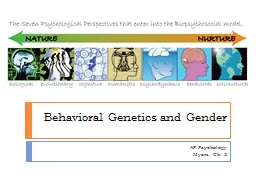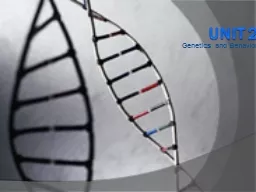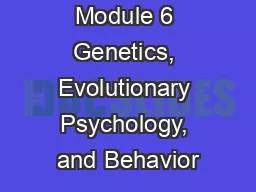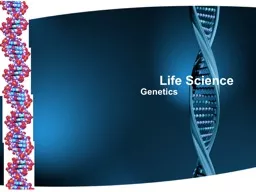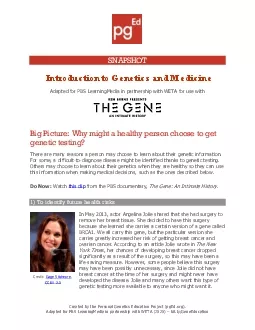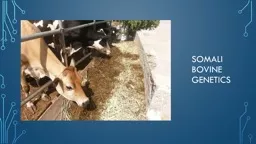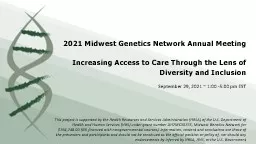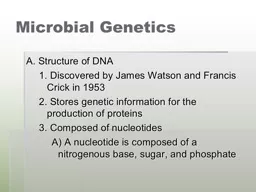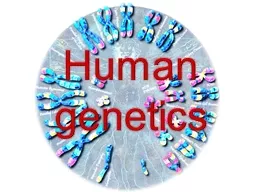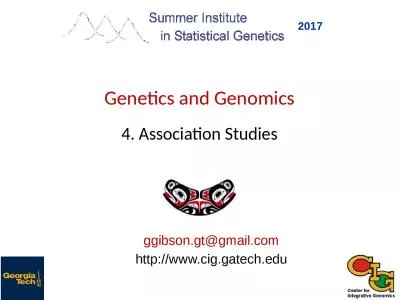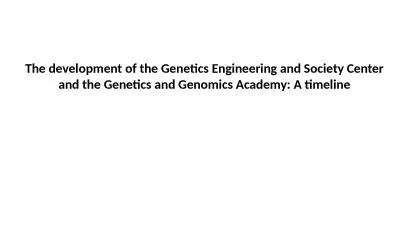PPT-Behavioral Genetics and Gender
Author : faustina-dinatale | Published Date : 2016-11-21
AP Psychology Myers Ch 3 What Makes You You Nature Genetics Genes Heredity Nurture Environmental circumstances Culture Parents Peers Behavioral Genetics The
Presentation Embed Code
Download Presentation
Download Presentation The PPT/PDF document "Behavioral Genetics and Gender" is the property of its rightful owner. Permission is granted to download and print the materials on this website for personal, non-commercial use only, and to display it on your personal computer provided you do not modify the materials and that you retain all copyright notices contained in the materials. By downloading content from our website, you accept the terms of this agreement.
Behavioral Genetics and Gender: Transcript
AP Psychology Myers Ch 3 What Makes You You Nature Genetics Genes Heredity Nurture Environmental circumstances Culture Parents Peers Behavioral Genetics The study of relative power and limits of genetic and environmental influences on behavior. Foundation of Gender Concepts:. What . I. s Gender?. Gender . refers to the social differences between males and females that are learned, and though deeply rooted in every culture, are changeable over time, and have wide variations both within and between cultures. . Next Generation Sequencing:. A technical perspective. Bristol Genetics Laboratory. Joanne Davies. Genetic Technologist. Objectives. Summarise the NGS assays currently available at BGL. Look at the general challenges with NGS assays. A. Structure of DNA. 1. discovered by James Watson and Francis Crick in 1953. 2. stores genetic information for the production of proteins. 3. composed of nucleotides. A) a nucleotide is composed of a nitrogenous base, sugar, and phosphate. Genetics and Behavior. Behavior Geneticists. study our differences and weigh the relative effects of heredity and environment.. Chromosomes, Genes, and DNA. Chromosomes. . (46 in each sell) containing . 6-1: . WHAT ARE . CHROMOSOMES, DNA, GENES. , AND THE HUMAN . GENOME. ? HOW DO BEHAVIOR GENETICISTS EXPLAIN OUR INDIVIDUAL DIFFERENCES?. Environment: . Every nongenetic influence, from prenatal nutrition to the people and things around us . Objectives. State the history of genetics;. Describe major century events;. Define terms used in genetics . History of Genetics. People have known about inheritance for a long time.. --children resemble their parents. How are genes, chromosomes, and heredity “related” to one another?. Standards:. S7L3a. Explain the role of genes and chromosomes in the process of inheriting a specific trait.. http://www.yourgenome.org/landing_dgg.shtml. pgEdorgAdapted for PBS LearningMedia in partnership with WETA 2020 bitly/GeneEducationSNAPSHOTIntroduction to Genetics and MedicineAdapted for PBS LearningMedia in partnership with WETA for use withBi Background. Somali Bovine Genetics established 2015 and is a leader in bovine genetics and artificial breeding technology in Somalia. . SBG. provides quality genetics and related products to farmers in Somalia. We maintain a fully staffed imported semen distribution facility and liquid nitrogen production center, complete animal feed mill in Mogadishu, Somalia. In the coming months we will plan to set up feed analysis laboratory and milk processing plant with prober cold chains.. Increasing Access to Care Through the Lens of . Diversity and Inclusion. September 29, 2021 ~ 1:00 -5:00 pm EST. This project is supported by the Health Resources and Services Administration (HRSA) of the U.S. Department of Health and Human Services (HHS) under grant number UH7MC30775, Midwest Genetics Network for $764,748.00 (0% financed with nongovernmental sources). Information, content and conclusions are those of the presenters and participants and should not be construed as the official position or policy of, nor should any endorsements by inferred by HRSA, HHS, or the U.S. Government. 1. . Discovered . by James Watson and Francis Crick . in 1953. 2. . Stores . genetic information for the production of proteins. 3. . Composed . of nucleotides. A) . A . nucleotide is composed of a nitrogenous base, . Lectures. . – . 17x2 (Med); . 17x1. (. Stom. ). ;. Seminars. – . 17x3 (Med); . 17x2. (. Stom. ). ;. 3 . concluding . tests. (. tests. + . practical part. ). Final . examination . (. tests. + . 2017. ggibson.gt@gmail.com. http://www.cig.gatech.edu. Outline. General . overview of association . studies. Sample Results. Three steps to GWAS:. Primary scan. Replication. Fine mapping. Individual Site Score. and the Genetics and Genomics Academy: A timeline. 1990. 1995. 2000. 2005. 2010. 2015. 2020. NIH sponsored. Genetics Graduate Training . Program in the . Genetic Architecture of . Quantitative Traits.
Download Document
Here is the link to download the presentation.
"Behavioral Genetics and Gender"The content belongs to its owner. You may download and print it for personal use, without modification, and keep all copyright notices. By downloading, you agree to these terms.
Related Documents

